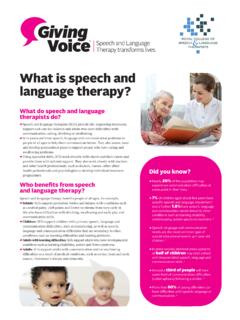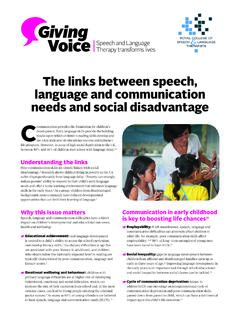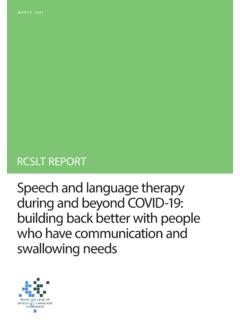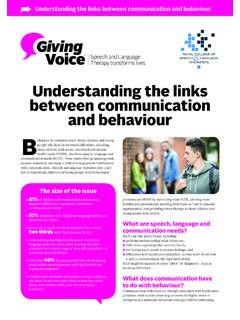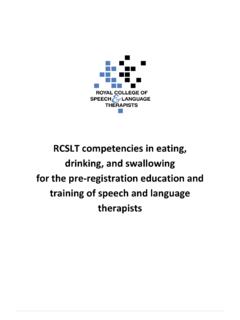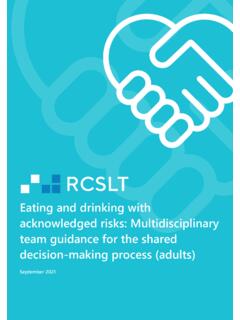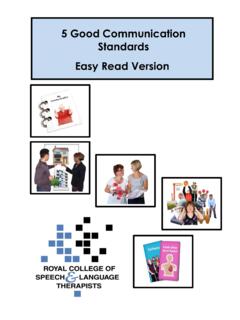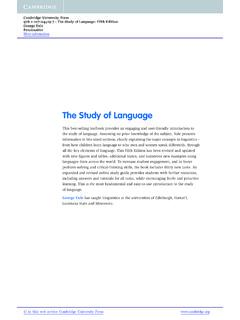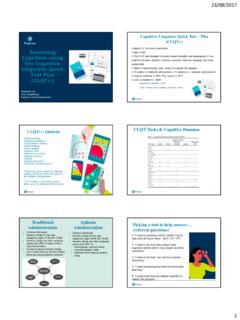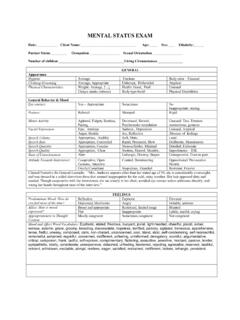Transcription of What are speech, language and communication needs?
1 The term speech, language and communication needs (SLCN) describes difficulties across one or many aspects of communication including: problems with producing speech sounds accurately stammering voice problems, such as hoarseness and loss of voice problems understanding language (making sense of what people say) problems using language (words and sentences) problems interacting with others. For example, difficulties understanding the non-verbal rules of good communication or using language in different ways to question, clarify or describe thingsSome SLCN are short term and can be addressed through effective early intervention. Others are more permanent and will remain with a person throughout their childhood and adult has SLCN?
2 Speech, language and communication needs can occur in childhood as primary difficulties with speech, language and communication or secondary to other developmental conditions such as autism. They can also be acquired in adulthood. Children Speech, language and communication needs are some of the most common childhood disabilities: 7% of children aged about five years have specific speech and language impairment1 and a further have SLCN linked to other conditions, such as learning disability, cerebral palsy and autism spectrum 40% of five-year-old children with all cleft types have speech A quarter of children with cerebral palsy are ,5 They are also linked with social disadvantage.
3 More than half of children in socially deprived areas may start school with impoverished speech, language and communication conditions that appear in childhood, such as stammering or speech impairment disorders, often cause SLCN in children and young people. Some conditions are present from birth and individuals may need support throughout their lives. For example, children with cerebral palsy often experience difficulty articulating particular speech sounds, while some cannot make themselves understood at are speech, language and communication needs? TMAdults Nearly 20% of the population experience communication difficulties at some point in their One-third of stroke survivors experience aphasia (a language disorder caused by brain injury).
4 People with aphasia often have 20% of people with head or brain injury have speech disorders often cause SLCN in adults. For example, brain injury or progressive illnesses can occur at any point across an individual s life span. A third of stroke survivors say their ability to understand, speak, read or write is affected by their condition and everyday tasks, such as answering the telephone, become Tomblin JB, et al (1997). Prevalence of Specific language Impairment in Kindergarten Children , Journal of Speech, language and Hearing Research, 40, pp. 1245-60. Enderby P, et al (2013). Beyond the Anecdote Examining the need for, and provision of, AAC in the United Kingdom.
5 communication Matters. Briton L, et al (2014). A Cross-Sectional Cohort Study of Speech in Five-Year-Olds With Cleft Palate 6 Lip to Support Development of National Audit Standards, Cleft Palate Craniofacial Journal, July 2014, Vol. 51 No. Nordberg A, et al (2013). Speech problems affect more than one in two children with cerebral palsy: Swedish population-based study, Acta Paediatr. 2013 Feb;102(2):161-6. doi: Epub 2012 Nov 25 Cerebral Palsy Institute (2009). Australian Cerebral Palsy Register, Report 2009, Birth Years 1993-2003, Sydney: Cerebral Palsy Locke A, Ginsborg J, Peers I (2002). Development and disadvantage: Implications for the early years and beyond.
6 International Journal of language and communication Disorders, 37(1), pp. National Children s Bureau (2012). Early support for children and young people and families: information about cerebral Scottish Executive Social Research (2007). communication support needs a review of the literature. Department of Health. National Stroke Strategy. 200710 Enderby, op. Royal College of Speech and language Therapists (2009). Resource Manual for commissioning and planning services for SLCN: aphasia . 12 Royal College of Speech and language Therapists (2009). RCSLT Resource Manual for Commissioning and Planning Services for SLCN: Autistic Spectrum Department of Health (2013).
7 Annual Report of The Chief Medical Officer 2012, Our Children Deserve Better: Prevention Pays. Bryan K, Freer J, Furlong C. language and communication difficulties in juvenile offenders. International Journal of language and communication Difficulties, 2007; 42, Elliott N. (2009). An Investigation into the communication Skills of Long-Term Unemployed Young Men. University of Glamorgan. For more information visit: AND RESOURCESWhy is it important to address SLCN?Speech, language and communication needs can have a detrimental impact on the quality of life of both children and adults. For example, conditions such as aphasia and dysarthria (difficulty speaking caused by problems controlling the muscles used in speech) can cause difficulties in communicating basic needs, holding conversations and participating in social situations.
8 In the case of individuals with severe and complex needs, they may experience profound problems in both understanding and using language and have severe social interaction , language and communication needs can also have a direct impact on children s development and educational outcomes, health and If left unaddressed, they can adversely affect children across their life span. For example, as many as 60% of young offenders and 88% of long-term unemployed young men have been found to have ,15 Speech and language therapy can helpSpeech and language therapists assess and treat SLCN in people of all ages to help them to communicate to the best of their ability. Using specialist skills, SLTs work directly with clients, carers and other professionals to develop personalised strategies that support people with SLCN.
9 They also provide training and strategies to the wider workforce, such as teachers and care assistants, so they can identify the signs of SLCN, improve the communication environment of people with SLCN, and provide effective support.
